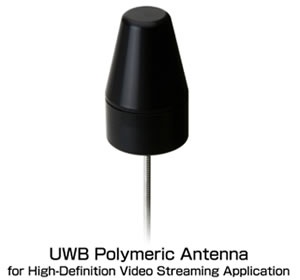OMRON Develops World's First Commercial Ultra-Wideband (UWB) MIMO Antenna for High-Definition Video Transmission
- Provides antenna for TZero's UltraMIMOTM UWB solution -
- Optimized to deliver an unrivaled, standards-based, telecast quality, consumer experience -
FOR IMMEDIATE RELEASESeptember 25, 2006
TOKYO, Japan - OMRON Corporation (TSE: 6645, US: OMRNY), a global leader in electronic components, sensing and control technologies, announced that it will release the world's first commercial polymer antenna for Ultra-Wideband (UWB communications see note 1) targeted toward high-definition (HD) and other telecast quality video transmission applications. Shipping in mass production volume to High Definition television (HDTV) as well as related DVD and projector equipment manufacturers is scheduled to start in spring 2007. The new antenna will be unveiled for preview at OMRON's booth in the CEATEC JAPAN 2006 exhibition to be held at Makuhari Messe, near Tokyo, October 3-7, 2006.
OMRON's latest UWB antenna addresses a clear market need as growing numbers of consumers worldwide upgrade to enjoy the superior HD viewing experience. HDTVs and related DVD players and scalers equipped with this antenna enable consumers to experience telecast quality HD video in their homes, while eliminating the cost and inconvenience of unsightly cables and wires.
Viewing HD content wirelessly requires stable and reliable video transmission. Multiple Input, Multiple Output (MIMO see note 2) wireless technology that optimizes chipset design with antenna, to prevent typical jitters and flickers, can provide this reliability. In particular, demand has been increasing from HDTV ODMs and OEMs for a high-performance antenna optimized with the UltraMIMO technology (see note 3) developed by Silicon Valley based, Tzero Technologies, a leading provider of UWB chipsets for high-quality, wireless, video transmission. Now, in a world-first, OMRON has met this need with a polymer antenna that maintains flatness in gain and omni directivity (see note 4) within standards-based UWB guidelines.
"The antenna is an important part of any wireless solution," said Dan Karr, senior vice president of sales and marketing for Tzero. "OMRON provides an exceptional implementation - optimized for the challenging application of video transmission - that should meet the needs of even the most demanding consumer device manufacturer."
Previously, on June 1, 2006, OMRON launched the WXA-N1SL SMD Polymeric Antenna for Ultra-Wideband (UWB) applications as the first in a series of wireless, high-frequency Wi-PlaDsTM devices (see note 5). By applying its proprietary molding technology to polymer, which lends itself to versatile shaping and mass production, OMRON plans to develop a variety of wireless products under the Wi-PlaDsTM brand, including antennas to suit a wide range of device configurations.
Key Features
- Delivers gain flatness and omni directivity in standards-based UWB
- Polymer-based antenna that can be molded in various shapes to fit perfectly and optimize space in a variety of devices.
- Optimized to work with UWB MIMO solutions such as TZero's Ultra-MIMOTM technology, which minimizes packet loss to ensure flicker-free and jitter-less image transmission.
Planned Specifications
| Model No. | WXA-S1FL |
|---|---|
| Size (╬”x H) | ╬”23 x 39.5 mm |
| Frequency range | 3.1 to 4.9 GHz |
| VSWR | 3 max. |
| Gain | 0 dBi max. |
| Flatness for each bandwidth | 3 dB max. (reference value) |
| Omni directivity | 2 dB max. (reference value) |
Note: The above specifications may be changed.

Note 1: UWB Communications:
UWB (Ultra-wideband) is a next-generation, short-range, high-speed wireless transmission technology that uses ultra-wideband electro-magnetic waves, and is suitable for use in wireless USB and image transfer applications. Commercial use of UWB communications was approved in the United States in February 2002 and in Japan in August 2006.
Note 2: MIMO Technology:
MIMO (Multiple Input Multiple Output) technology spatially increases the bandwidth for wireless communications by combining multiple antennas, thus making wireless communications even faster. The use of more than one antenna also stabilizes transmission and improves communications.
Note 3: UltraMIMO Technology:
UltraMIMOŌäó is Tzero's unique implementation of MIMO that enables links to continue delivering content flawlessly, even in the presence of hostile interferers. The performance gains of UltraMIMO include: increased range, increased link reliability and interference cancellation.
Note 4: Gain Flatness:
Denotes minimal variation in gain for each frequency within defined ultra-wide bandwidth.
Note 5: Wi-PlaDs Ōäó:
Wi-PlaDs is a registered trademark for OMRON's wireless high-frequency devices. The name derives from "Wireless Polymeric Advanced Devices."
About OMRON
Headquartered in Kyoto, Japan, OMRON Corporation is a global leader in the field of automation. Established in 1933 and headed by President and CEO Hisao Sakuta, OMRON has more than 27,000 employees in over 35 countries working to provide products and services to customers in a variety of fields including industrial automation, electronic components, social systems (ticket gate machines, ticket vending machines, and traffic control), and healthcare. The company is divided into five regions and head offices are in Japan (Kyoto), Asia Pacific (Singapore), China (Shanghai), Europe (Amsterdam) and US (Chicago). For more information, visit OMRON's website at www.omron.com.
- For sales related enquiries, please contact:
- Masaharu Tsujimoto (info_wiplads@omron.co.jp)
Telephone: +81 77 565 6199
WiPlaDs website :https://www.omron.com/ecb/products/whfd/index.html
- For media related enquiries, please contact:
- James Seddon (james_seddon@omron.co.jp)
at OMRON Corporate Communications Department
Telephone: +81 3 3436 7202
















